Understanding the Intricate Composition of Pearls
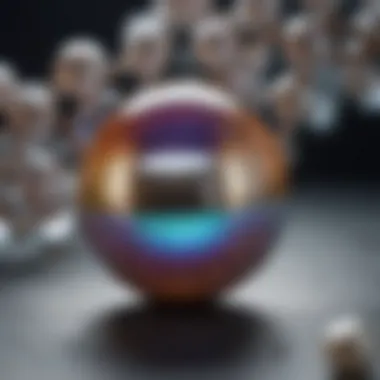

Intro
Gemstone Overview
Definition and Origins
From a biological perspective, pearls form inside the soft tissue of certain mollusks, primarily oysters and clams. When an irritant, such as a grain of sand, enters the shell, the mollusk secretes layers of nacre to coat it. Over time, these layers accumulate, creating the pearl. Nacre, also known as mother-of-pearl, consists of aragonite and conchiolin, which are proteins that give pearls their iridescent quality.
Historically, pearls have held significance across various cultures. Ancient civilizations, such as the Chinese and Romans, treasured pearls for their rarity and beauty, often associating them with power and wealth. Their allure captivated jewelry makers, leading to the creation of intricate designs that remain popular today.
Historical Significance
The fascination with pearls dates back thousands of years. Historical texts indicate that pearls were highly sought after in Ancient Egypt, where they adorned the crowns of pharaohs. In the Roman Empire, pearls were worn by aristocrats as a sign of status. Different cultures attributed varying meanings to pearls, with some viewing them as symbols of purity while others considered them tokens of love and devotion. This rich history enhances the value of pearls in contemporary jewelry, as they continue to represent sophistication and a deep connection to tradition.
Gemstone Properties
Hardness and Durability
Pearls differ from other gemstones in terms of hardness and durability. On the Mohs scale, pearls range between 2.5 to 4.5, making them softer than many popular gemstones like diamonds and sapphires. This softness requires careful handling; scratching can easily mar their surface. Proper storage away from harder materials helps maintain their pristine condition.
Color and Clarity
The color of pearls is influenced by various factors, including the species of mollusk and the environment in which they grow. Common colors include white, cream, and shades of pink, with rare varieties exhibiting deep hues such as black or gold.
The clarity of a pearl refers to the smoothness of its surface and the absence of blemishes. Higher-quality pearls have fewer imperfections, which significantly influences their market value. When considering pearls for collection or design, assessing these aspects is essential for understanding their worth.
"The enchanting beauty of pearls arises not only from their aesthetic appeal but also from the intricate processes that shape their existence."
Pearls are not just gemstones; they are the result of natural phenomena that highlight the unique characteristics of the mollusks from which they originate. Their rich history, coupled with their biological and chemical structures, makes them a fascinating subject for exploration and admiration.
Intro to Pearls
Pearls have fascinated humans for centuries. This article provides a detailed exploration of their composition. Understanding pearls starts with grasping their origins and characteristics. Each pearl tells a story, from how they form to the cultures that value them.
Definition and Characteristics of Pearls
A pearl is a hard, lustrous object produced within the soft tissue of a living mollusk. Most commonly, this occurs in oysters and mussels. Notably, pearls are unique in the gemstone world because they are organic. They form as a defense mechanism against irritants like parasites or foreign objects. When a mollusk encounters such an irritant, it secretes layers of nacre around it. This nacre, or mother-of-pearl, is mainly composed of calcium carbonate and gives pearls their distinctive luster.
The characteristics of pearls vary greatly. They can be classified by size, shape, color, and luster. Natural pearls tend to be rare and are sought after for their uniqueness. Cultured pearls, however, are more common and come from farms where humans induce the formation process. Both types hold value but differ in how they are sourced.
Historical Significance and Cultural Perspectives
Throughout history, pearls have held a significant place in culture and commerce. In ancient civilizations, they symbolized wealth and status. For example, Cleopatra famously claimed to possess the largest pearl in history, showcasing its value in society.
Different cultures regard pearls with varying significance. In Asia, they are symbols of purity and are often used in traditional wedding attire. In the West, pearls are frequently associated with elegance and sophistication, used widely in jewelry for formal occasions. The reverence for pearls can be seen in literature, art, and religious texts. As time evolves, so does the appreciation for pearls, highlighting their steadfast allure in human society.
"A pearl is a silent language of strength and beauty, cherished across history and culture."
Biological Foundations of Pearls
The biological foundations of pearls are integral to understanding their formation and characteristics. This section will uncover the symbiotic relationship between mollusks and their environment, shedding light on the essential processes that lead to pearl production. Recognizing the biological aspects reveals not just how pearls form but also factors that influence their quality and variety. This knowledge is vital for enthusiasts and collectors alike as they appreciate and evaluate these remarkable gemstones.
The Role of Mollusks in Pearl Formation
Mollusks are the primary architects of pearls. When an irritant, such as a grain of sand, enters a mollusk's shell, it triggers an extraordinary response. The mollusk excretes layers of nacre around the irritant as a defense mechanism. This nacre, composed mainly of calcium carbonate, builds up over time to form a pearl. Understanding this process is essential because it connects the biological behavior of mollusks with the quality and uniqueness of the pearls produced.
The ability of mollusks to respond to irritants leads to the creation of pearls, a fascinating natural phenomenon that merges biology with art.
The type of mollusk involved can significantly impact the resulting pearl. Both the species of mollusk and the environment in which it lives affect the pearl's characteristics, including its luster, color, and shape.
Types of Mollusks Producing Pearls
Mollusks are categorized mainly into two groups: freshwater and saltwater types, each having unique roles in pearl production.
Freshwater Mollusks
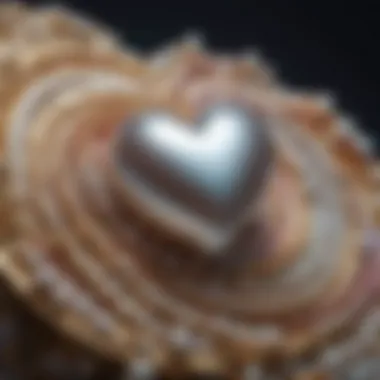
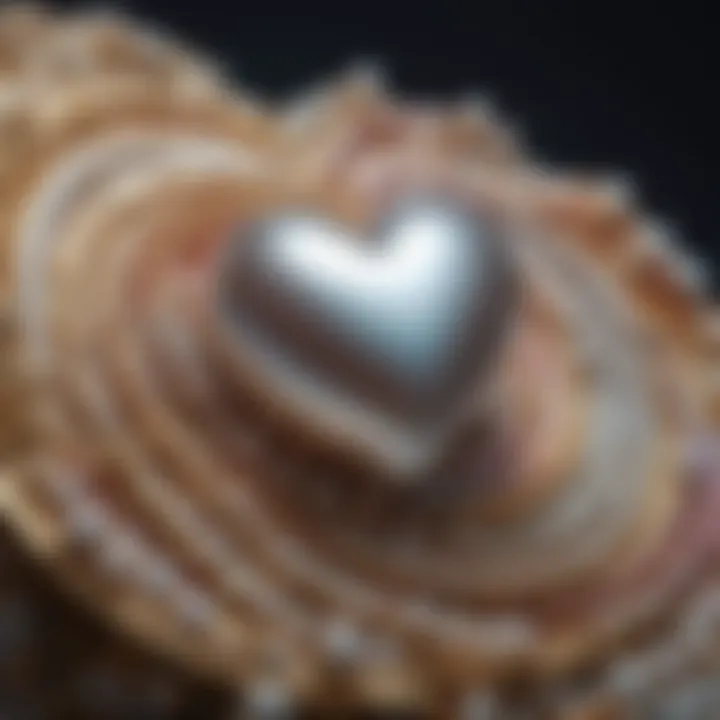
Freshwater mollusks, particularly those from the family Unionidae, contribute significantly to the pearl market. These mollusks can produce many pearls in a single shell, making them efficient providers of this gemstone. One key characteristic of freshwater mollusks is their ability to thrive in rivers and lakes, which provides a diverse habitat for pearl formation.
The ability to produce multiple pearls per mollusk is a notable advantage for pearl cultivators. Freshwater pearls tend to exhibit a wider range of colors and shapes, appealing to a broader audience. However, they often have a less lustrous finish compared to saltwater varieties.
Saltwater Mollusks
Saltwater mollusks, such as the Pinctada species often used in cultured pearl farming, are prized for producing high-quality pearls. A defining feature of saltwater mollusks is their typically singular focus on forming one pearl, resulting in a more unique and often more valuable gem.
The nacre from saltwater mollusks is known for its superior luster and luminous quality. This characteristic makes saltwater pearls particularly desirable in high-end jewelry markets. However, they are usually harder to cultivate due to specific environmental requirements, which can limit availability and drive up prices.
Chemical Composition of Pearls
The chemical composition of pearls is a fundamental aspect that sheds light on their unique qualities and characteristics. Understanding this composition helps enthusiasts grasp why different pearls exhibit such a variety of colors, luster, and overall beauty. The primary elements that make up pearls influence not only their aesthetic appeal but also their durability and value in the gemstone market. This section will describe two critical components of pearls: calcium carbonate and organic materials, which together define what pearls are at a molecular level.
Primary Components: Calcium Carbonate
Calcium carbonate is the main constituent of pearls, constituting approximately 90% of their structure. This compound is primarily found in the form of aragonite, a form of calcium carbonate that forms in a particular crystal structure. The presence of this material is what gives pearls their distinct shine and smooth texture.
Calcium carbonate is not only a structural element but also part of the nacre layers, which reflect light in various ways, enhancing the luster of the pearl. As mollusks secrete nacre, they layer calcium carbonate platelets to form lustrous surfaces. This process relies heavily on the quality and concentration of calcium carbonate in the surrounding waters.
Furthermore, the way calcium carbonate crystallizes significantly impacts the appearance of the pearl. Conditions such as water temperature, mineral content, and pH level of the environment can lead to variations in crystallization patterns, thereby affecting color and iridescence. Knowing these factors is crucial for collectors and jewelers alike, as they inform decisions related to pearl valuation.
Role of Organic Materials in Pearl Structure
In addition to calcium carbonate, pearls contain significant organic materials that play a vital role in their overall composition. These organic components primarily include conchiolin, which acts as a protein matrix that binds the aragonite layers together. This interaction between organic and inorganic materials contributes to the pearl's strength and flexibility.
Organic materials perform several functions in the pearl structure:
- Binding: They help to adhere the layers of calcium carbonate, enhancing the structural integrity.
- Color Influences: Organic compounds can also affect the hue and iridescent quality of pearls based on their source and environmental conditions.
- Formation Process: Organic molecules are essential during the secretion of nacre, guiding the growth of the pearl as the mollusk continues to add layers over time.
The intricate interplay of these organic and inorganic components underlines the complexity of pearl formation, making them not just beautiful objects but also remarkable examples of natural engineering.
"The beauty of pearls lies not only in their exterior luster but deeply within their chemical composition, where science meets art."
The chemical interplay of calcium carbonate and organic materials provides essential insights for those interested in pearls, offering a deeper appreciation for these organic gemstones and their journey from sea to jewelry.
The Process of Nacre Formation
Nacre formation is a fundamental process in the creation of pearls. It is vital for understanding not only how pearls are formed but also their quality and unique features. Nacre, often referred to as mother-of-pearl, is the substance that gives pearls their luster and beauty. In this section, we will explore the definition and function of nacre as well as the stages involved in its layering. This understanding is essential for anyone interested in pearls, from collectors to designers, as it affects the appeal and the value of these gemstones.
Definition and Function of Nacre
Nacre is a composite material, primarily made up of aragonite and conchiolin. Aragonite is a form of calcium carbonate, and conchiolin is an organic protein. The structure of nacre is layered, which contributes to the beautiful iridescence of pearls.
The function of nacre goes beyond aesthetics. It serves as a protective layer for the mollusk’s soft tissues, especially when an irritant, such as a grain of sand, enters its shell. The layer of nacre forms around the irritant, leading to the development of a pearl over time. This protective mechanism is essential for the survival of the mollusk and showcases the natural defensive abilities of these creatures.
Stages of Nacre Layering
The process of nacre layering occurs in distinct stages, each contributing to the development of the pearl. Here are the primary phases:
- Initial Reaction: When an irritant enters the mollusk, it triggers a defensive response. The mollusk secretes nacre to envelop the irritant. This initial layer serves as a barrier between the irritant and the mollusk's body.
- Layer Formation: As time progresses, the mollusk continues to secrete nacre, layering it over the previous coatings. This layering happens continuously and can take several years, depending on environmental conditions and the type of mollusk.
- Maturity: Over time, the pearl grows as more nacre layers are added. A well-formed pearl consists of numerous layers, which contribute to its luster and iridescence.
"The quality of nacre layers is a key indicator of a pearl's value; thicker, more lustrous layers yield higher quality pearls."
- Final Shape and Size: The pearl eventually reaches a size and shape that is determined by various factors, including the type of mollusk and the environment it inhabits. The final appearance of the pearl is largely attributed to the thickness and quality of the nacre layers.
Understanding the process of nacre formation is significant for anyone involved in the pearl industry. It not only influences the quality of pearls but also impacts their value. Collectors and jewelry designers can appreciate the nuanced factors that contribute to the allure of pearls, guiding their choices in selection and valuation.
Environmental Influences on Pearl Quality
The quality of pearls is significantly shaped by various environmental factors. Understanding these influences allows enthusiasts and collectors to appreciate pearls to the fullest. Factors like water quality, temperature, and the availability of suitable food sources all contribute to the characteristics of pearls. This section delves into these elements, providing a framework for understanding their role in pearl formation and development.
Impact of Water Quality and Temperature
Water quality is an essential aspect influencing pearl quality. Clean, unpolluted water fosters a healthy environment for mollusks. Polluted water can lead to poor pearl quality due to stress on the mollusks. Pearls produced in polluted environments often show flaws or irregularities in shape and luster.
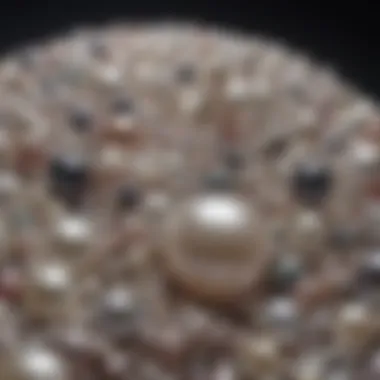
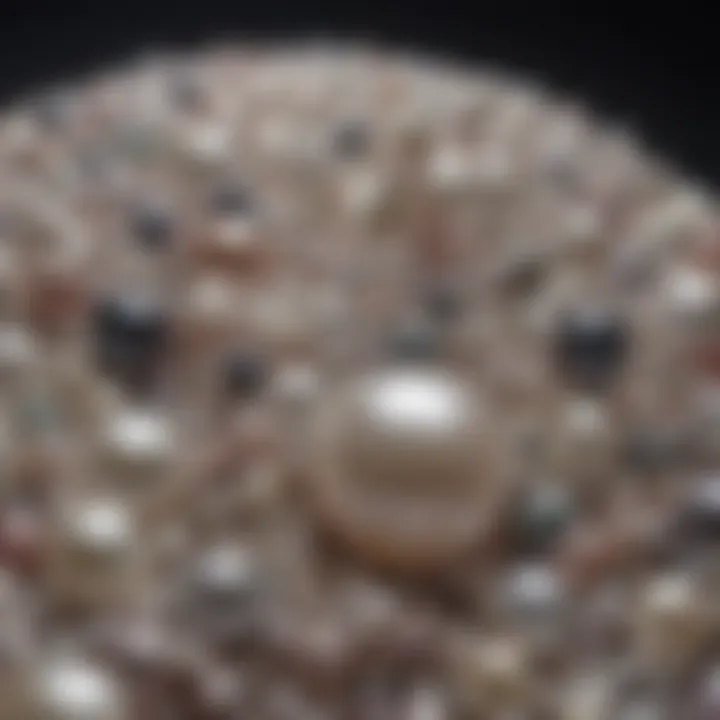
Additionally, temperature plays a crucial role in the growth rate of pearls. Warmer waters tend to accelerate the production of nacre. However, extreme temperatures can stress the mollusks, affecting their ability to produce high-quality pearls. Optimal temperature ranges vary, but typically, 20°C to 30°C conditions yield the best results for saltwater and freshwater mollusks.
"Water quality is fundamental; it affects not just the health of the mollusks, but the characteristics of the pearls they produce."
Ensuring the right balance of salinity and temperature is also vital. Salinity can vary depending on location and season, influencing the mollusks' biology. Overall, the right environmental conditions result in pearls with superior qualities like shine and uniformity.
Role of Food Source in Pearls' Development
The food source available to mollusks directly impacts their growth and, consequently, pearl quality. Mollusks primarily feed on plankton, which can be influenced by both natural and human-made factors. Low food availability can lead to slower growth rates and less nacre production. High-quality pearls require consistent and plentiful food resources.
In addition, the type of food can affect the final product. A diverse diet allows mollusks to optimize their health, thus enhancing nacre layers in pearls. Furthermore, specific types of plankton provide better nutritional values. As a result, pearls produced under ideal feeding conditions tend to achieve greater luster and a more desirable appearance.
In summary, understanding environmental influences on pearl quality reveals the complexities of their production. From water quality and temperature to food availability, these factors shape the pearls we see in jewelry today. Knowledge of these elements equips gemstone enthusiasts with a greater appreciation for the intricacies of pearl formation.
Classification of Pearls
The classification of pearls is crucial for understanding their characteristics and value. This section will clarify the two main categories of pearls: natural and cultured. It also highlights the various types of cultured pearls, which vary significantly in appearance and quality.
Natural vs. Cultured Pearls
Natural pearls are formed without any human intervention. They occur when an irritant, such as a grain of sand, enters a mollusk. The animal layers nacre around the irritant, gradually forming a pearl. The rarity of natural pearls contributes to their high value in the gemstone market.
Cultured pearls, on the other hand, are manufactured through human intervention. A technician deliberately introduces an irritant into the mollusk, stimulating pearl formation. This process has made pearls more accessible and has diversified the types available on the market. Both types share the same basic characteristics, but their origins impact their significance and price.
Different Types of Cultured Pearls
Akoya Pearls
Akoya pearls are known for their classic round shape and high luster. Originating mainly from Japan, they are often used in traditional pearl jewelry. Their size ranges typically from 6 to 8 mm. Akoya pearls are popular for their consistent quality and elegant appearance. However, they may be more prone to surface imperfections compared to other types, which can affect their value.
Tahitian Pearls
Tahitian pearls are unique due to their dark colors, which can vary from black to green and blue. These pearls are primarily farmed in French Polynesia. Their sizes usually range from 8 to 14 mm. The exotic look and large sizes are appealing to many collectors. The unique color of Tahitian pearls adds to their desirability. Some buyers may find the darker pearls less versatile in matching with outfits.
South Sea Pearls
South Sea pearls are among the largest and most sought-after. They are primarily harvested in Australia and the Philippines. Their size can range from 9 to 20 mm. South Sea pearls are celebrated for their incredible luster and natural colors, including white, silver, and golden. While they often command high prices, their unique color options make them an attractive choice for high-end pearl jewelry. However, their cost can limit accessibility for some consumers.
Understanding the classification of pearls enriches one’s appreciation and knowledge of these beautiful gems.
This classification not only helps in identifying the right type of pearl for various purposes but also plays a critical role in the market dynamics of gemstones. Knowing the differences can guide consumers in making informed decisions when purchasing pearl jewelry.
Pearl Grading and Value Assessment
Pearl grading and value assessment play a crucial role in the understanding and appreciation of pearls. This process not only helps collectors and consumers identify the quality of pearls but also assists in determining their market value. By exploring the various factors that influence pearl value, one can make informed decisions when purchasing or selling these gemstones. An understanding of these elements can enhance the overall experience related to pearl jewelry, elevating both personal enjoyment and investment potential.
Factors Influencing Pearl Value
Each pearl's value is influenced by several key factors. These include size, shape, color, and luster. Understanding these elements can provide insights into what makes one pearl more valuable than another.
Size
The size of a pearl significantly impacts its value. Larger pearls tend to be rarer, thus making them more desirable in the market. For many collectors, size is one of the primary criteria when considering a purchase. The key characteristic of size is that it directly correlates with rarity. As pearls grow, they require a considerable amount of time to develop. Therefore, larger sizes can exhibit a higher price point.
However, larger pearls also come with some disadvantages. The larger the pearl, the more likely it is to have surface imperfections. This can detract from its overall appeal. Collectors must weigh the allure of size against potential flaws when assessing value.
Shape
Shape plays another important role in determining a pearl’s value. Round pearls are the most sought-after shape, as they are perceived as perfect and symmetrical. This quality makes them more valuable. Many buyers prioritize the round shape for high-end jewelry pieces.
On the other hand, unique shapes, known as baroque pearls, can be appealing due to their individuality. While they may not carry the same price tag as perfectly round pearls, their distinctive shapes can attract collectors looking for something different. The trade-off often lies between conventional appeal and unique design.
Color
Color can greatly influence the desirability of pearls. Different colors evoke various reactions and preferences among consumers. Natural colors, such as white, pink, and black, each hold unique market values. For instance, Tahitian pearls are particularly valued for their dark, exotic colors.
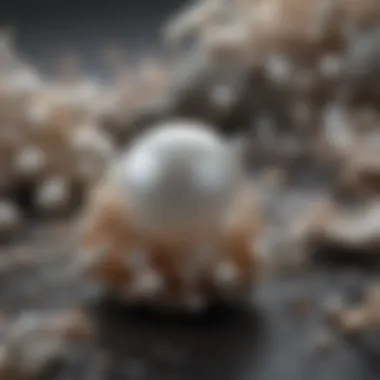
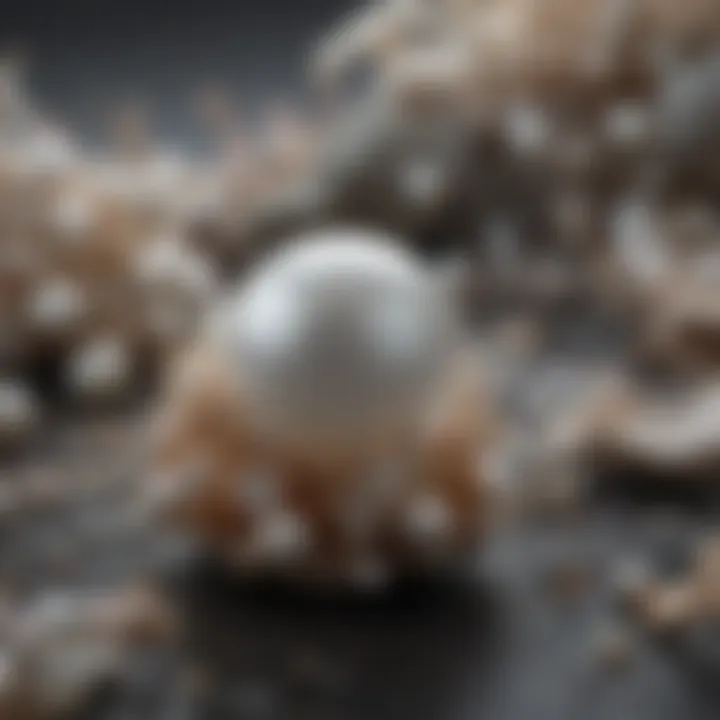
However, certain colored pearls may also be more accessible, resulting in lower prices. For example, white pearls, while timeless, may not hold the same market dynamism as more exotic colors. Thus, while color can enhance a pearl's visual appeal, it can also affect its perceived value significantly.
Luster
Luster refers to the sheen or glow that a pearl exhibits. Good luster is essential for a high-quality pearl and is often a critical factor in grading. High-luster pearls display a bright, reflective surface. This characteristic can enhance the overall visual impact of a piece of jewelry. The brilliance adds to its allure.
Poor luster can diminish value considerably. For example, dull or chalky pearls are less desirable, impacting the overall perception of quality. Assessing luster is vital for anyone seeking to understand pearl value comprehensively.
Understanding Pearl Grading Systems
The grading of pearls follows systematic methods that take into account the previously discussed factors. Each grading system combines these elements to provide an overall evaluation of a pearl's quality. Various standards exist within the industry, often created by gemological organizations.
It is beneficial for collectors and enthusiasts to familiarize themselves with these grading systems. They vary but are essential tools for ensuring informed purchases. By grasping these standards, one can appreciate the nuances and subtleties that influence pearl grading and value.
Caring for Pearls
Caring for pearls is vital for maintaining their beauty and longevity. As organic gemstones, pearls require special attention compared to traditional stones like diamonds or sapphires. The unique composition of pearls and the delicate nature of their nacre make proper care crucial. Neglecting these practices can lead to significant deterioration, thus affecting their aesthetic value in jewelry.
Best Practices for Pearl Jewelry Maintenance
To preserve the luster and quality of pearl jewelry, consider these best practices:
- Store Separately: Keep pearls away from other jewelry to avoid scratches. A soft cloth pouch or a dedicated jewelry box is ideal.
- Avoid Chemicals: Chemicals in perfumes, hairsprays, and even lotions can damage the nacre. Therefore, it is best to apply these products before donning pearl jewelry.
- Cleaning with Care: Use a soft, damp cloth to clean pearls after wearing. This removes impurities that can dull their shine. Avoid using ultrasonic cleaners or harsh detergents.
- Limit Exposure to Heat and Sunlight: Prolonged exposure to sunlight or heat can cause the pearls to lose their natural oils, leading to a dry, dull appearance.
- Regular Inspections: Check pearl necklaces for loose knots and other signs of wear. If loose pearls are found, consider restringing them.
Common Mistakes to Avoid
Being aware of common mistakes can help maintain pearls effectively:
- Wearing During Activities: Avoid wearing pearl jewelry during activities that may expose them to impact or harsh conditions, such as swimming or exercising.
- Storing with Other Jewelry: Storing pearls with harder gemstones can lead to scratches and loss of luster.
- Neglecting Regular Cleaning: Forgetting to clean pearls after use can result in build-up that may damage their surface over time.
- Using Harsh Cleaners: Avoid any cleaners that contain abrasives or ammonia. These substances can erode the nacre.
- Over-polishing: Excessive polishing can wear down the surface of pearls, leading to a loss of their natural beauty.
Proper care and maintenance can extend the life of pearls significantly, allowing their beauty to shine for generations.
Taking these care tips into account will enhance the longevity of pearls. Their unique composition requires a delicate approach to handling and maintenance, but the reward for such diligence is the enduring beauty and charm of these exquisite gems.
The Future of Pearls in Gemstone Markets
The realm of pearls is undergoing significant transformations. As gemstone markets evolve, the dynamics surrounding pearl cultivation, distribution, and consumption are also changing. These shifts are crucial for consumers, collectors, and industry stakeholders. Gaining insight into these trends helps enthusiasts make informed decisions while appreciating the artistry of pearls. The future indicates a blend of tradition and innovation, particularly centered on sustainability, technological advancement, and market demand.
Emerging Trends in Pearl Cultivation
In recent years, pearl cultivation has experienced notable shifts. There is a growing interest in the cultivation of unique pearls that are distinct from conventional offerings. Aquaculture systems are being refined, allowing for greater customization of pearl characteristics, including shape and color. This is largely driven by consumer demand for unique, individualized pieces.
Another trend is the enhancement of farming techniques. Advanced methods, such as selective breeding, enhance the quality of pearls while maintaining ecological balance. Farmers are also adopting practices that improve the health of mollusks, which plays a crucial role in producing high-quality pearls. Emphasis on efficiency and quality does not come at a cost to the environment, reflecting a broader move toward sustainable practices in aquaculture.
"Emerging trends in pearl cultivation emphasize quality over quantity, allowing artisans to explore new possibilities in design and structure."
In addition to technology integration, educational initiatives are being implemented. Aspiring pearl farmers are now encouraged to learn about environmental impacts and good aquaculture practices. This ensures the longevity of the pearl industry while simultaneously enhancing the reputation of cultured pearls among consumers.
The Role of Sustainability in Pearl Trade
Sustainability is central to discussions about the future of pearls in the marketplace. As consumer awareness rises, there is a pronounced shift toward ethically sourced gems. Buyers are now seeking assurances that their purchases support environmentally responsible practices. Consequently, pearl farms are becoming increasingly transparent about their methodologies.
Sustainable practices include habitat preservation, minimizing pollution, and using native species in pearl farming. These initiatives help maintain biodiversity and reduce the ecological footprint of pearl production. More consumers equate sustainability with quality and uniqueness, making these factors vital to the future of the gemstone sector.
Furthermore, certifications for sustainable pearls are gaining traction. Organizations are developing standards that guide ethical sourcing and production practices. This is especially true for brands that market environmentally conscious products, creating models for transparency in the pearl trade.
Ultimately, the confluence of sustainable practices and evolving cultivation methods presents a promising future for pearls in the gemstone market. As these elements take center stage, the perception of pearls is likely to shift, with consumers viewing them not just as luxury items but also as responsibly sourced treasures.
Ending
Summary of Key Insights on Pearl Composition
During our journey through the composition of pearls, we have uncovered several key insights. First, the biological origins of pearls lie in mollusks, which secrete layers of nacre as a defense mechanism. This nacre, primarily made of calcium carbonate, forms the bulk of the pearl’s structure. In addition, organic materials play a significant role in maintaining the integrity of the pearl, providing both strength and texture. Furthermore, environmental factors such as water quality, temperature, and the mollusk's diet directly affect the pearl’s development and final characteristics.
The classification of pearls into natural and cultured varieties adds another layer of complexity. Each type, whether it be Akoya, Tahitian, or South Sea, carries distinct traits that reflect the unique conditions of their growth environments.
Importance of Understanding Pearl Characteristics
A deep understanding of pearl characteristics enables collectors and jewelry designers to make informed decisions. For collectors, knowledge about the factors that influence pearl quality enhances their ability to identify valuable pieces. For jewelry designers, this knowledge serves as a foundation for creating unique designs that maximize the beauty and value of the pearls they select.
Overall, recognizing the intricate details of pearl composition aids in appreciating these natural wonders far beyond their visual appeal. With the added focus on sustainability in pearl trade, understanding these factors will become increasingly essential for all stakeholders involved in the gem market.



